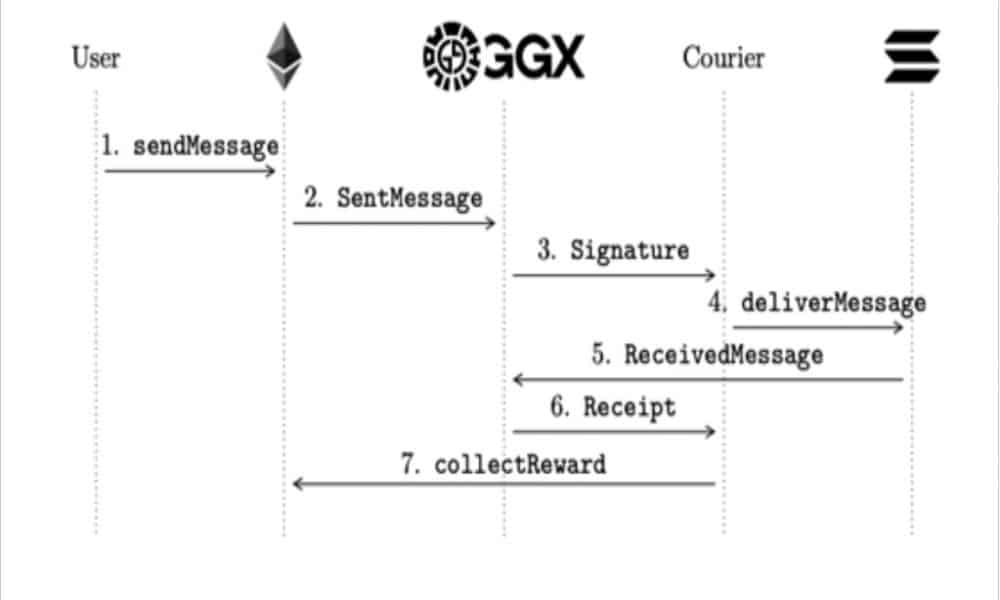Press Release
Golden Gate’s (GGX) cross-chain unification with multi-party computation

Blockchain-based systems often involve the need for sensitive data to be protected while also performing specific operations on that data. The most common example is public-private key cryptography, whereby cryptographic keys need to be kept secret but are needed to initiate transactions. Golden Gate, a novel interchain infrastructure protocol that solves the interchain communication and liquidity transfer challenges that plague other smart contract L1s across the Web3 industry, integrates this type of cryptography and builds upon the shoulders of cryptographic giants with its native use of Multi-Party Computation (MPC), combining this improved set of technologies to strengthen the security and integrity of operations that occur on Golden Gate which is now is active TestNet.
Golden Gate’s Distributed Algorithm
Golden Gate employs MPC for distributed secp256k1 key generation and threshold signatures, a cutting-edge technology that revolutionizes the safe generation of secp256k1 ECDSA signatures. Golden Gate’s innovative approach utilizes the techniques described in the renowned 2020 paper “One Round Threshold ECDSA with Identifiable Abort” by Gennaro and Goldfeder.
Gennaro and Goldfeder’s paper showcases their expert use of zero-knowledge cryptography, which is widely recognized and respected within the industry. By incorporating their cryptographic protocol into Golden Gate’s framework, we achieve a revolutionary distributed algorithm that enables the coordination of secure Multi-Party Computation while generating secp256k1 signatures. This breakthrough technology allows decentralized custody of the “Total Value Locked” (TVL) of tokens used in bridging, providing users with comprehensive security and trust.
Using distributed threshold signatures in Golden Gate presents significant advantages over alternative solutions. Unlike zkSNARK and multi-signature approaches, which require multiple signatures and extensive computational resources, MPC produces a single secp256k1 signature. This streamlined process results in highly efficient cross-chain bridging, reducing the computational “gas” required for executing smart contracts on a blockchain.
“Golden Gate is at the forefront of innovation in the blockchain space,” said Matthew Doty, Chief Architect and Science Officer at Golden Gate who in 2014 was among the first two research hires by the Ethereum Foundation, and in 2015 co-wrote the Ethereum Mining Algorithm with Vitalik Buterin. “By leveraging Gennaro and Goldfeder’s breakthrough cryptographic techniques and implementing distributed threshold signatures, we can offer a comprehensively secure, efficient, and decentralized solution. Our mission is to unify isolated infrastructure and protect liquidity across Web3.”
For scalability, Golden Gate serves as a relay chain connected to various parachains. For efficient cross-chain communication, Golden Gate uses a novel Incentivized Message Delivery Protocol (IMDP). IMDP uses a network of couriers running light clients to deliver messages and earn rewards from user fees. A call to Golden Gate’s smart contracts triggers the courier network and works as pictured in the sequence diagram below:

Protocol Agnostic Base-layer Communications
Harmonization of cross-chain communications and liquidity interaction standards is crucial for the future of decentralized systems and which Golden Gate is solving. The ability for different blockchains to interact with each other allows for more complex applications, better liquidity, and increased efficiency across Web3. MPC within Golden Gate plays a significant role in improving the security, privacy, and functionality of cross-chain interactions including the ability for Secure Asset Transfers, Atomic Swaps, privacy-preserving cross-chain interactions, and more.
In all of these cases, the critical advantage of MPC is that it allows for the distributed, trustless operation of cross-chain functions for Golden Gate. MPC enhances decentralization, comprehensive security, and privacy. Golden Gate’s Multi-Party Computation represents another ingredient in the stack of combined technologies, including zk-precompiles, an embedded hybrid virtual machine, protocol agnostic communication standards, and Nominated Proof of Stake that Golden Gate harnesses to support its growing ecosystem of Novel DeFi and cross-chain dApps.
To find out more join Golden Gate’s discord to begin getting involved in their TestNet or follow them on Golden Gate’s Twitter.
ABOUT GOLDEN GATE
Golden Gate (GGX) is interchain infrastructure that delivers protocol-agnostic cross-chain communications and liquidity routing, featuring comprehensive security architecture. Golden Gate is delivering a next-generation programmable layer 0, with an embedded hybrid virtual machine, and advanced DeFi orchestration capabilities that contributes critical infrastructure for Web3’s emerging “Internet of Blockchains.” Golden Gate is developed by a team that collectively helped build key components of our industry’s first generation fragmented infrastructure, now with the mission to bring frictionless composability and enhanced security standards to Web3.
Contact Details: Golden Gate, Lisa Loi, info@ggxchain.io
Disclaimer: This is a paid post and should not be treated as news/advice.

![Bitcoin [BTC]](https://ambcrypto.com/wp-content/uploads/2025/06/Gladys-5-1-400x240.webp)